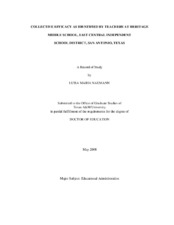| dc.description.abstract | The primary purpose of this study was to investigate the collective efficacy of
teachers at Heritage Middle School in the East Central Independent School District in
San Antonio, Texas, and to determine the relationship between selected demographic
variables and the teachers' collective efficacy. The variables included teachers' ethnicity, gender, years of teaching at Heritage Middle School in the East Central
Independent School District, total years of teaching, and highest degree earned. The
researcher used the collective efficacy survey short form instrument developed by Roger
D. Goddard to assess the campus's collective efficacy survey. Answers to the following
questions were sought in this study.
The first question studied was, "What is the perceived collective efficacy as
reported by teachers at Heritage Middle School, East Central Independent School
District in San Antonio, Texas?" The results of the study indicated that the teachers who
participated in the study all mildly agreed that they had the ability to make all the
students at Heritage Middle School successful. The second question studied was, "What is the relationship between selected
demographic variables and the perceptions of the teachers regarding collective efficacy
at Heritage Middle School, East Central Independent School District in San Antonio,
Texas?" The results indicated that there were no statistically significant differences
between the variables of gender, ethnicity, length of time in the classroom, length of
time in the district, and length of time in the profession and the teachers' collective
efficacy.
During the 10 years that the Heritage Middle School has been in operation, there
have been six different principals resulting in six different approaches to the
management of the school. No research was found that explains how a school's
collective efficacy is affected when there are numerous administrative changes. Further
research that examines the relationship between stability of leadership and collective
efficacy of teachers is needed. | en |


